We grow cucumbers in a greenhouse: the rules of care from planting to harvest
Cucumbers are good both in everyday cuisine and on the festive table. To grow a bountiful harvest of vegetables, it is best to do it in a greenhouse, especially in cooler climates. Subject to the light and temperature conditions, regular ventilation, control of the humidity level, top dressing, weeding and the formation of bushes, the culture will delight you with an excellent result.
The content of the article
What to consider when growing cucumbers in a greenhouse
Important Factors in Indoor Cultivation - the choice of the greenhouse itself and varieties... For such conditions, varieties of cucumbers are more suitable, resistant to temperature extremes and high humidity, adapted for growing on trellises.
Preference is given to varieties and hybrids with high yields and long-term fruiting.
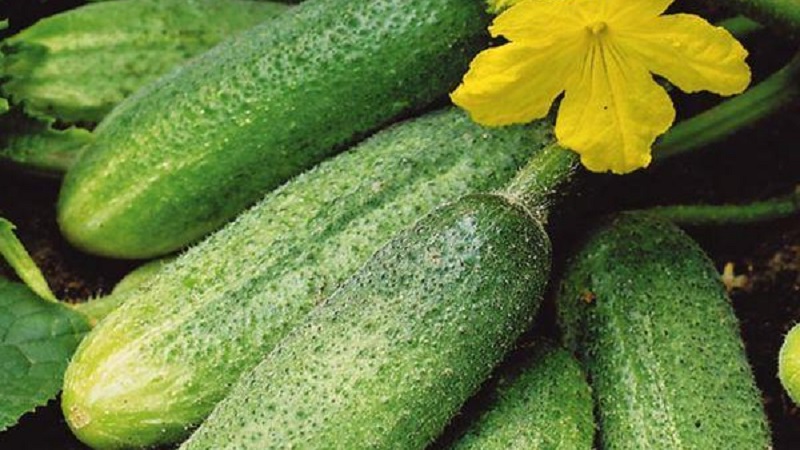
Greenhouse preparation
Modern greenhouses are made of polycarbonate... The material is resistant to mechanical damage, moisture, transmits sunlight well.
Greenhouse preparation begins in autumn: all plant residues are removed in it, garden tools, trellises, props, buckets are taken out. All parts of the structure are disinfected with bleach from pests.
Important! If any part of the greenhouse is out of order or covered with mold, rot, it is replaced with a new one.
Selection of variety and hybrid
When choosing a vegetable crop for indoor ground, they are guided by the yield indicator and immunity. 2-3 different varieties are planted in the greenhouse.
Early:
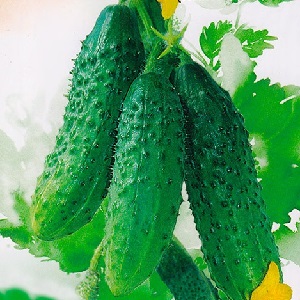 Sarovskiy F1 (photo on the right) - high-yielding hybrid (15.5 kg / m2) with bouquet fruiting. Vegetables are tied in low temperatures and low light.
Sarovskiy F1 (photo on the right) - high-yielding hybrid (15.5 kg / m2) with bouquet fruiting. Vegetables are tied in low temperatures and low light.- Muromsky 36 - yields a harvest in 32–44 days. Ripe vegetables turn yellow quickly, so they are harvested daily.
- Masha F1 - a hybrid resistant to olive spot, cucumber mosaic virus and powdery mildew. Cucumbers are medium in size and taste great for canning.
- Suomi F1 - resistant to powdery mildew and cladosporiosis. Fruits begin to give 38 days after the first shoots. Productivity - 14.2 kg / m2.
- Valaam - has strong immunity to many diseases. Cucumbers do not outgrow, they are suitable for fresh consumption, canning for the winter.
Self-pollinated:
- Cupid F1 - bears fruit in a bouquet, is resistant to diseases, gives up to 14 kg of vegetables from 1 m2.
- Herman F1 - hardy to climatic conditions, has immunity to powdery mildew, tobacco mosaic, cladosporium. Productivity - up to 9 kg / m2.
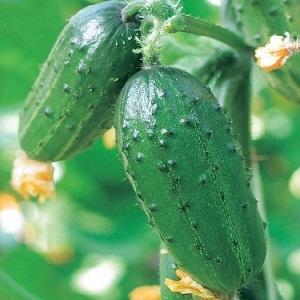 Bouquet F1 - yields a harvest in 30 days. Low branching allows planting at 1 m2 up to 6 plants.
Bouquet F1 - yields a harvest in 30 days. Low branching allows planting at 1 m2 up to 6 plants.- Courage F1 - tolerates temperature changes well and does not succumb to diseases. Productivity - 16-18 kg / m2.
- Stay healthy F1 (pictured) - forms mini-gherkins 6-9 cm long, which are suitable for fresh salads and canning.
- Anyuta F1 - early ripening hybrid with a high yield (12-16 kg / m2). Resistant to cucumber mosaic, olive spot, powdery mildew, susceptible to downy mildew.
- Petrel F1 - vegetables ripen 39–42 days after the first shoots. The hybrid has a strong immunity to diseases, the yield is up to 13 kg / m2.
Soil preparation
Fertile and air-permeable greenhouse soil - the guarantee of a good harvest of cucumbers.
A loamy or sandy loam soil with a pH of 7 is suitable for the culture.... Reduce acidity with lime. The optimal soil for cucumbers is turf or humus. To increase fertility, 50% of peat, 30% of humus and 20% of field soil are added to the soil.
Important! A month before the picking of the seedlings, the soil is dug up, biomass is introduced to enrich the composition and the beds are formed.
Seed preparation
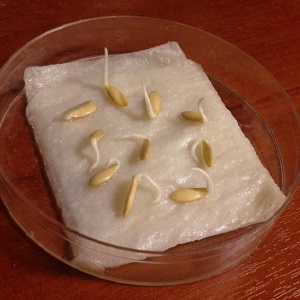 For greenhouses, seeds are taken 2-3 years ago.: they show great yields. Last year's seeds are heated at a temperature of + 55 ... + 60 ° C.
For greenhouses, seeds are taken 2-3 years ago.: they show great yields. Last year's seeds are heated at a temperature of + 55 ... + 60 ° C.
For disinfection, planting material is poured with a solution of potassium permanganate at the rate of 1 g per 0.5 tbsp. water. Leave in solution for 20 minutes, then rinse thoroughly with running water.
To stimulate growth and development, seeds are hardened... First, soak in water at room temperature for 12 hours. When they swell, they are transferred to the refrigerator for 16-18 hours, then they are kept for 6-7 hours at + 18… + 20 ° С. This procedure is carried out within 4-5 days.
Before sowing, the grain is kept warm for 2-3 daysuntil they start sprouting.
Growing seedlings
For cucumber sprouts, take a mixture of 4 parts of peat and turf, 1 part of sawdust and manure. Another option: 6 parts of humus, 3 parts of turf and 1 part of sand.
For disinfection, the soil is calcined in an oven or poured with a solution of potassium permanganate.
Attention! The containers are also disinfected with a solution of potassium permanganate.
Cucumbers are planted immediately in separate cups, a drainage hole is made in each. The soil is added by half. The seeds are sprinkled with soil 2 cm. To stimulate growth, add "Epin". The containers are covered with a transparent film to create a greenhouse effect, placed in a sunny place.
Optimum temperature for emergence - + 25 ° C. When sprouts appear, the film is removed.
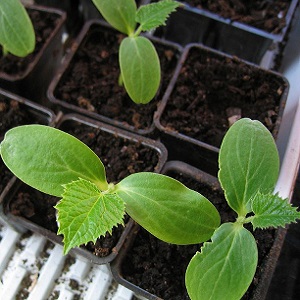 Conditions for the rapid growth of seedlings:
Conditions for the rapid growth of seedlings:
- good illumination;
- temperature + 18 ... + 20 ° С;
- watering regularly with warm water so that the soil does not crumble if you take it in your hand;
- applying liquid dressings every 10 days (alternating organic and mineral fertilizers).
Young plants are often infected with powdery mildew, turn yellow... It is important to follow the care scheme, maintain the temperature regime, moisten the soil and regularly air the plantings.
Important! When grown early, there is a risk that seedling will outgrow and weaken, will not give a good harvest.
Planting
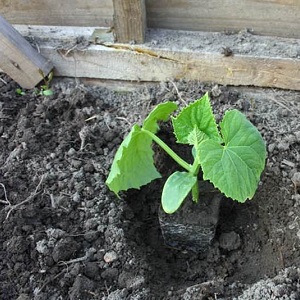 2 weeks before the pick, the seedlings begin to hardengradually lowering the air temperature and regularly ventilating the room. Every day, the hardening time is increased by 1-2 hours.
2 weeks before the pick, the seedlings begin to hardengradually lowering the air temperature and regularly ventilating the room. Every day, the hardening time is increased by 1-2 hours.
To the greenhouse seedlings are planted in a checkerboard pattern to a depth equal to the height of the containers with sprouts. The flowers that appear are removed.
The sprouts are removed carefully, leaving a clod of earth on the roots. It is not necessary to deepen the seedlings. The distance between the bushes is at least 50 cm, otherwise the adult plants will interfere with each other.
Immediately after planting, cucumbers are watered warm water.
Greenhouse care
From planting to harvest, cucumbers in the greenhouse require care. After picking the seedlings, the beds are covered with polyethylene or reinforced with foil. After 3-5 days, when the seedlings take root and get stronger, the film is removed.
Watering mode
Seedlings are watered sparingly for foliage growth and abundant budding... During flowering, the bushes are moistened every other day. More frequent watering is allowed if the leaves begin to dry out. Water the crop abundantly when setting the fruit.
The optimal time for watering: in the morning - until 10:00, in the evening - at 18-22 hours.
Top dressing
Cucumbers in greenhouses fertilize in several stages:
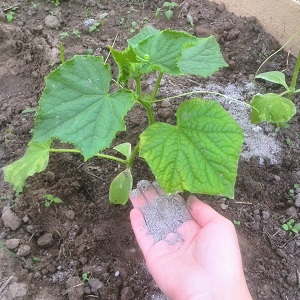 On the 3-4th day after disembarkation, ammonium nitrate is used.
On the 3-4th day after disembarkation, ammonium nitrate is used.- 15 days after, they are fed with complex fertilizer. A mixture of potassium sulfate, superphosphate, urea is suitable.
- By the beginning of budding, the complex is added again.
- After 2-3 weeks, add mullein, superphosphate and potassium sulfate.
- After another 2 weeks, chicken manure and a complex of mineral fertilizers with a high phosphorus content are introduced.
Light mode
In case of insufficient natural light, greenhouses install lamps... Cucumbers should be illuminated for at least 12 hours per day. There are no breaks between natural and artificial lighting.
Duration of complete darkness for cucumbers - 6 hours... This creates conditions for them for natural physiological processes.
Temperature regime
Temperature for picking seedlings - + 20 ... + 23 ° С, for flowering - + 25 ... + 28 ° С... The ovaries are well formed at + 20 ... + 35 ° С. Fruiting will be abundant at + 25 ... + 30 ° С.
Important! Low temperatures are detrimental to cucumbers: at + 15 ° C, the growth of lashes and stems slows down, at + 10 ° C the bushes stop developing, and at + 8 ° C they die.
Airing and humidity
Ventilate the greenhouse daily to avoid the growth of fungi and bacteria... At the same time, make sure that the temperature does not fall below the permissible value.
A high level of humidity is suitable for greenhouse cucumbers: for air - 75–90%, for soil - at least 80%.
Formation of bushes
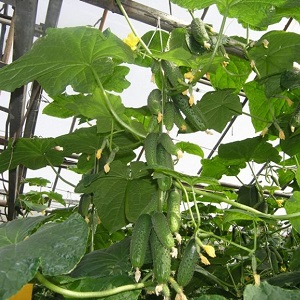 To prevent ripening vegetables from rot, plants start tie up 3-4 weeks after disembarkation, when their height reaches 30–35 cm.
To prevent ripening vegetables from rot, plants start tie up 3-4 weeks after disembarkation, when their height reaches 30–35 cm.
In greenhouses, a garter structure is made up to 2 m high... A frame is constructed, the upper bar of which is placed under the ceiling, and the other at the bottom. They connect everything with strong ropes.
The tops of the tied cucumbers are pinchedto slow down the growth of the main stem. Otherwise, the plants will begin to wrap around the walls of the greenhouse and prevent the flow of light.
When young shoots-stepsons begin to grow from the central lashes of cucumbers, they are removed. If this is not done, useful substances will be spent on shoot growth, instead of feeding the main stem.
Pollination
Do not grow in greenhouses self-pollinated cucumbers together with bee-pollinated: insects will land on all plants and damage them first.
To help the bushes with pollinationThe pollen is gently transferred between flowers with a brush.
Protection against diseases and pests
 The main diseases of greenhouse cucumbers: powdery and downy mildew, root rot, brown spot, gray and white rot, black mold, copperhead (anthracnose).
The main diseases of greenhouse cucumbers: powdery and downy mildew, root rot, brown spot, gray and white rot, black mold, copperhead (anthracnose).
For prophylaxis, planting material is disinfected, the soil is weeded in a timely manner. Landings are treated with "Topaz", copper sulfate, Bordeaux liquid.
The main insect pests of cucumbers: whiteflies, aphids, slugs, thrips, bears, spider mites.
Against them, the plants and the greenhouse are sprayed with karbofos, "Inta-Vir", "Fitoverm". The concentration of karbofos for the bushes is taken 2 times less than for the greenhouse itself.
Important! Ants contribute to the spread of aphids and larvae of other pests, therefore, when anthills appear near greenhouses, they are immediately destroyed.
Harvesting
Since different varieties are planted in greenhouses and they ripen at different times, the harvest is harvested as the vegetables ripen... During the period of active fruiting, cucumbers are removed every 2 days.
Low-quality copies are disposed of, regardless of their degree of maturity... Remove the vegetables carefully so that the stalk remains on the stem. The best time to pick cucumbers is early morning or evening.
Tips
Seasoned gardeners willingly share the secrets of growing greenhouse cucumbers:
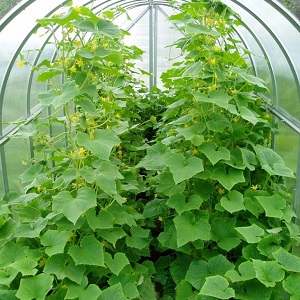 If you press the stem to the ground and sprinkle it with moist soil, the culture will develop a powerful root system. This will increase yields.
If you press the stem to the ground and sprinkle it with moist soil, the culture will develop a powerful root system. This will increase yields.- Productivity is affected by the content of carbon dioxide: to saturate the air with it, dry ice cubes are laid out in the greenhouse, manure is used as mulch, containers with mullein are placed.
- The growth of cucumbers accelerates feeding with milk (1 part water, 2 parts milk).
- The more often vegetables are harvested without allowing them to gain maximum weight, the higher the yield.
- The plantings are mulched with freshly cut grass, sawdust, manure, straw, peat, non-woven materials. The mulch layer and the stems should not touch.
Conclusion
Growing cucumbers in a greenhouse is a laborious process that, subject to agrotechnical practices, gives a high-quality result. First, they prepare the greenhouse itself, select the right varieties or hybrids.
Plants are provided with optimal illumination, humidity and air temperature, they are engaged in the prevention of diseases, and do not allow overripening of fruits.